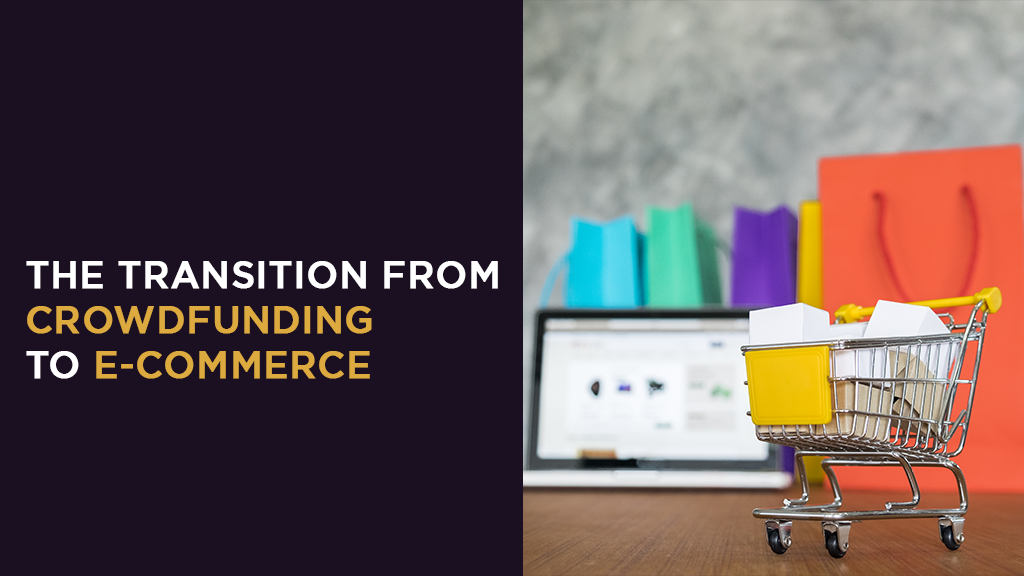
Crowdfunding is one of the most effective ways to bring a consumer product to market. There are multitudes of benefits like being able to generate marketing buzz and cheaper customer acquisition costs.
After you’ve earned market validation from a successful campaign, it becomes time to scale up to e-commerce to build your long-term brand. Think of it as the final phase of your crowdfunding journey.
But in order to successfully navigate to that phase, you need to do more than just stick to what worked on your crowdfunding platform. You need a comprehensive strategy when making the transition from crowdfunding to e-commerce.
Crowdfunding to e-commerce: paving the way for a successful store with backer support
Crowdfunding is one of the best methods for paving the way to a healthy e-commerce business, and that all has to do with tapping into a community of early adopters.
By validating your product with early adopters and achieving your first goal of raising crowdsourced funding, you’re then able to manufacture your product, ship to your backers, and produce enough inventory for e-commerce development.
This is where the scaling for your startup begins.
Contents
- Understanding the impact
- Leveraging crowdfunding as a launchpad
- Maximizing exposure and audience engagement
- Preparing crowdfunding resources for e-commerce launch
- Understanding campaign management differences
- Addressing the challenges of e-commerce launch
- Real-world success stories
- Final thoughts on transitioning from crowdfunding to e-commerce
Understanding the impact
LaunchBoom believes in giving creators a vision of the long-term potential of the crowdfunding journey. The impact that crowdfunding has on aspiring e-commerce businesses can be distilled into the LaunchBoom philosophy: “Test. Launch. Scale.”
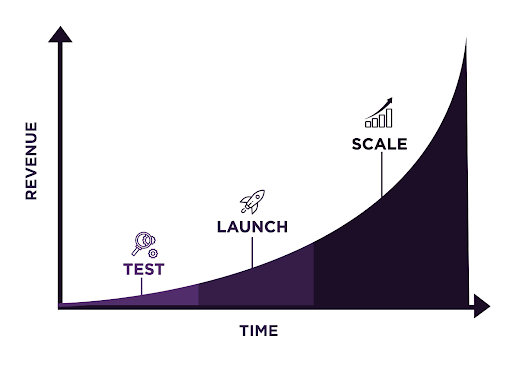
Let’s look at a quick breakdown of these terms to make it easier to follow.
- Test: Instead of jumping straight into an e-commerce venture, it’s advantageous to validate your product through methodical testing of product positioning and audience targeting. This phase takes place before you even launch your crowdfunding campaign, and gives you the opportunity to test ideas cheaply, quickly, and accurately so you know if your idea has a place in the market.
- Launch: Once you pass the testing phase, you’re set to launch on a crowdfunding platform like Kickstarter or Indiegogo. The goal during this phase is to pre-sell as much as you can to the market to not only raise funds but build momentum that can propel you into the next phase of online retail growth.
- Scale: The core strategy of scaling is for you to build on your crowdfunding success. Using what you’ve learned about marketing your product during testing and launching, you can drive more sales to your digital storefront and set yourself up for long-term success.
And while it’s true that you can do seven figures in sales in the first year of scaling on e-commerce, this framework doesn’t just end there. When thinking about the long-term, you might have more products in mind that you’d like to bring to market on your digital storefront. Crowdfunding can continue to work in your favor for those future products, too.
How does a crowdfunding campaign shape your future e-commerce business?
You can see how the LaunchBoom framework is meant to help you carry the momentum of a successful crowdfunding campaign into good e-commerce development, but the possibilities for scaling don’t stop there. Visualize the “test, launch, scale” roadmap as a circle:
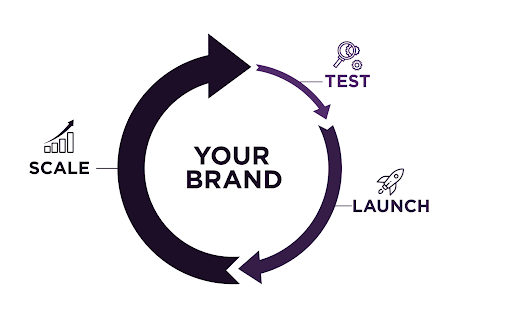
This strategy has the potential to feed on itself and serve as your online business model for continuous online retail growth and success. If you’ve been able to deliver a great customer experience, establish your brand, and rally support for your company, you can repeat the cycle again and again.
Once you’re in the scale phase, you can start working on your next great product ideas and start a brand new round of testing that will culminate in another successful crowdfunding campaign. We’ve seen successive campaigns not only go on to have bigger raises but become more profitable as well.
Now that you know what’s possible, let’s explore in greater detail the steps for leveraging crowdfunding as a stepping stone for your startup scaling journey.
Leveraging crowdfunding as a launchpad
There are a lot of risks that come with being an entrepreneur. While there’s no way to eliminate every risk, we have found crowdfunding launches to be a great way to mitigate at least some of the risks — especially when bringing unique new products to market.
Why? Well, there are a few reasons:
- Crowdfunding allows you to leverage a product prototype to start generating revenue without inventory. In traditional product launch strategies, you start by paying a huge investment upfront to manufacture a lot of your product. With crowdfunding, you don’t have to do that, thus mitigating the first major risk of upfront cost before you even start selling.
- Crowdfunding validates demand for your new product. Traditionally, after spending a ton of money to produce enough stock, creators then have to sink even more resources into marketing. Leveraging crowdfunding lets you flip the order so that you spend money marketing the promise of your product to find out if it’s something people really want.
- You get real-time feedback to help improve your product, your marketing, and your strategy. Backers, and even detractors, are invaluable sources of feedback that can lead to major breakthroughs for improving your product before completely switching to e-commerce.
All of these reasons have one common thread: the community of backers you’re able to build through crowdfunding. Not only is the audience for crowdfunding massive, it’s an eager community ready to engage with unique products and creators.
Crowdfunding: your test drive for audience engagement and product validation
What is it that makes the crowdfunding community a great incubator for product validation? It can best be explained by something called the “product adoption curve.”
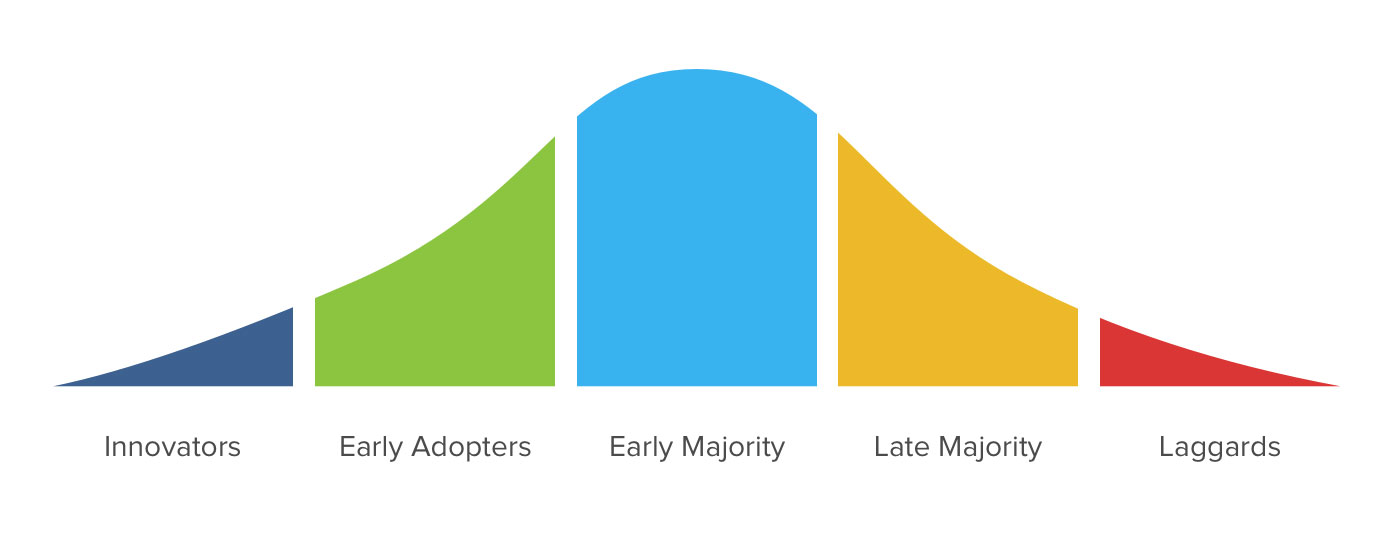
The “innovators” and “early adopters” are the people most likely to back crowdfunding campaigns and will be your test drivers for validating your product. Everyone has that friend who likes to brag about discovering something before it got big. This group of buyers is highly motivated to be the first to try, or back, new products. It’s much harder to tap into them if doing a traditional product launch strategy.
Now imagine having an entire marketplace with thousands of people like this where they can discover your product organically and kickstart your customer base growth. Actually, these already exist!
Maximizing exposure and audience engagement
Crowdfunding platforms like Kickstarter and Indiegogo are where you get to really maximize exposure and engagement, because they allow their communities to browse and discover live campaigns. Projects get ranked according to various factors, but it’s largely driven by popularity.
By following the LaunchBoom strategy for successful pre-launch, you can set yourself up for a huge first day of funding and propel yourself up the rankings and let the innovators and early adopters find you more easily. Historically, we’ve seen that at least 20% of total funds raised by the end of a campaign will have come from organic traffic on these sights.
In this way, your marketing dollars are getting stretched that much further since you don’t have to pay for additional traffic or exposure. The most important thing for you to worry about at this point is maintaining strong engagement with your backers in order to leverage them for the eventual switch from crowdfunding to e-commerce.
Building and leveraging your audience from crowdfunding to e-commerce
There are several effective ways to leverage your crowdfunding audience by keeping them engaged as you switch to e-commerce. Here are a few tactics that are easy to implement:
- Keep them updated: Your transition is going to be a busy one, making it a great opportunity to share new updates with your backers. Doing so gives them a sense of exclusive inclusion, and it is likely to resonate since they were the earliest adopters of your product.
- Behind-the-scenes looks: Giving your backers a peek behind the curtain is an extension of the first tip and is a great way to deliver visual content across social media channels. Behind-the-scenes videos on social media also have a chance to be shared, which is an organic way to generate new interest for your upcoming product release and bolster your customer base growth.
- Introduce exclusive rewards: Those who keep up-to-date with all of your engaging content should be rewarded. This may include offers like early access, exclusive discounts, or limited-edition releases for pre-orders.
Early adopters are always on the lookout for exclusive content like these, making them a vital part of your engagement strategy when bringing your crowdfunding backers over to your e-commerce business.
Preparing crowdfunding resources for e-commerce launch
By the end of your crowdfunding campaign, you’ll have accumulated many findings, visual assets, and resources. Instead of starting over from scratch, you can easily repurpose everything you have for your e-commerce strategy. A successful campaign proves that what you already have works, giving you your foundation for any future changes you might want to start testing.
But don’t feel like you have to rush.
Building your e-commerce site is a marathon, not a sprint, and we usually advise creators not to do so until they are firmly in the Indiegogo InDemand post-campaign phase. The purpose of continuing to have your product live on InDemand is because of the understanding people have that when they purchase there, it’s a pre-order.
If you cobble together a new e-commerce website too quickly because you want people to pre-order there instead, you risk unintentionally misleading people to believe that they are buying the products and will receive them immediately. Having your InDemand page up and running gives you a long enough runway to construct your official website on Shopify (the platform we always recommend due to its ease-of-use and abundant features).
Only when you have enough inventory to start selling on your e-commerce website should you go live, at which time you can also shut down your InDemand page. We recommend people to give themselves at least a two-month window for website construction before closing InDemand, giving them enough time to start putting their crowdfunding resources to good use.
It all starts with transitioning your best visual assets for your e-commerce strategy.
Transitioning visual assets and videos for e-commerce use
There aren’t many successful crowdfunding campaigns that don’t make use of great images and video. The same is arguably true for a great e-commerce website.
Start filling out your site with good quality images that you have, but consider doing professional photo shoots with the real product if you were only relying on renders for your campaign. An e-commerce site isn’t the place to use digital renders if you want to convey that your product is legitimate.
Additionally, you can start chopping up your campaign video into snippets to be used for social media shorts and gifs. Quick and informative content can be very valuable, and you can even make simple product walkthrough videos based on what you may have done in your campaign video.
Utilizing your crowdfunding email list for e-commerce marketing
Thanks to your pre-launch testing, you likely have the perfect email list that represents your ideal audience. You can utilize this list to produce a new lookalike audience that can greatly reduce your lead acquisition cost for e-commerce marketing.
Facebook will allow you to choose how big of an audience it should create within a range of 1 to 10% of a population. Note that the bigger you choose, the less specific the new lookalike audience will be. Start with a smaller lookalike audience, and then build from there based on how your new list performs.
Also, be sure to remove “crowdfunding” from any narrowing you might have applied to your audiences from before. You’re targeting the mass market now.
Leveraging social media channels from crowdfunding to e-commerce
Just as you leveraged social media channels and paid advertising for your campaign, the same works incredibly well for driving traffic to your new website. Of course, you want to use social media as a way to stay engaged with your current audience to guide them to your e-commerce site down the line, but you shouldn’t stop trying to generate a bigger audience.
By this point, you should have an idea of what ads work best for your product. You can repurpose them with slight tweaks in messaging that don’t mislead people about where you are in your e-commerce journey.
If you’re still on InDemand, guide them to that landing page and encourage them to pre-order. If your website is already up, make sure your ad reflects that information and lets new customers know that they can start buying and receiving immediately.
Engaging journalists and influencers: lists and strategies
Now that you have a successful campaign you can point to proving that your product has an audience, you can leverage that validation to get your upcoming e-commerce business some journalistic and influencer exposure.
Everyone is familiar with “listicles,” and how online content machines love publishing them as easy and engaging content for their readers. If your product fits in a product category that those types of websites would feature on a list article, you can try pitching it to them so they can review it and get your name out there to their audience.
The same principle applies to influencers. Consider this YouTube comparison review video that the MÄNNKITCHEN team was able to set up with a popular chef and influencer:

The Pepper Cannon is a product that home cooks and audiences in the food space would love to learn about, especially if it’s coming from an authoritative voice they can trust. A big reason why this influencer probably agreed to do a video like this, is because of how well the Pepper Cannon did on crowdfunding.
Understanding campaign management differences
It’s tempting to feel invincible after a successful crowdfunding campaign, which can give you the false security that it’s all going to work out in the e-commerce arena as well. While it’s good to be confident, it’s vital that you understand some of the differences in campaign management between crowdfunding and e-commerce.
From audience expectations to navigating the platforms you’re working on, the more you know about what might trip you up, the better you’ll do as you scale for the long term. Let’s look at five key differences.
5 key differences between managing crowdfunding and e-commerce campaigns
There are five major categories between managing crowdfunding and e-commerce campaigns that we have identified as having the biggest impact on the transition to e-commerce.
- Backer versus direct buyer behavior
- Conceptualizing versus selling
- Platform differences between crowdfunding and e-commerce
- Shipping, logistics, and customer care
- Managing costs
Some of them seem like they would directly overlap, but the subtle differences in each category are what you need to account for. Let’s start by exploring backer versus direct buyer psychology.
Backer psychology versus direct buyer behavior
We’ve touched on this briefly before when talking about the audience expectations when purchasing on an InDemand page versus an e-commerce site. Backers know that they will eventually be receiving a product; e-commerce customers expect to receive what they paid for within seven to ten business days.
Do not allow pre-orders on your e-commerce site. When running ads to drive traffic for pre-orders, always use an InDemand page instead for a greater return on ad spend. We’ve seen what happens when you do the opposite and have found that it really does come down to that subtle difference in buyer behaviors on each site.
But don’t underestimate the expectation backers have to receive their product in a reasonable amount of time. Make sure that your campaign backers receive their products before you go live on e-commerce. You need to honor your promise to them as the early adopters of your product that they can get theirs before anybody else.
Conceptualizing the product versus selling the finished product
If you never had a functioning prototype during your campaign, you need to make sure that each product functions as intended, comes with all features that were advertised, and that there were no oversights in packaging.
It’s easy to sell the concept of an awesome product, but you must understand that there’s big pressure to deliver when selling it when it’s finished. Take the time to quality control everything as it comes in, and make sure to do it before you need to start fulfilling orders.
You don’t want to start breaking trust with your customers right as you’re getting your e-commerce business off the ground.
Navigating platform differences and e-commerce setup
There are a lot of great e-commerce platforms to choose from like BigCommerce, Wix, or SquareSpace. They each have their pros and cons, but we strongly recommend Shopify. Aside from being very user-friendly with over 6,500 apps and plugins to choose from, nearly half of those apps are free to use. These tools are essential for tasks like fulfilling orders, generating sales reports, and connecting to social media.
But aside from choosing the right platform for your e-commerce site, you have to know how to optimize it. Campaign pages are restrictive in how you can design them, in that they are only meant to scroll down linearly.
E-commerce sites, on the other hand, need to be built like a funnel. Every page needs to be designed to make the viewer take an action, with the final step being a purchase. Here’s an example of that customer journey using MÄNNKITCHEN:
HOME PAGE: This is the first thing customers see, with the big “SHOP NOW” button prompting them where to click.
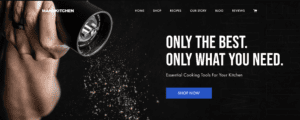
SHOP NOW: The “SHOP NOW” button then takes them to the page with the most popular product: the Pepper Cannon. From here, it’s clear that we want them to “ADD TO CART”
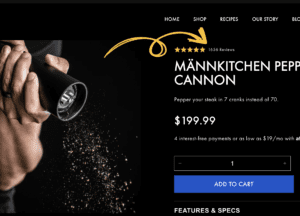
ADD TO CART: Finally, customers are taken straight to the page where they can then proceed to “CHECKOUT” — the last stage of the funnel.
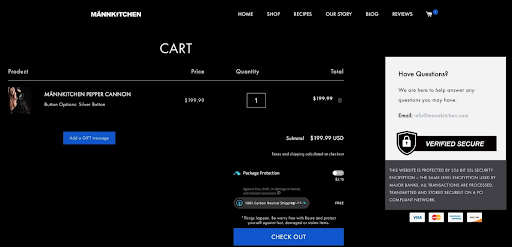
There are no ambiguities about how the customer can get your product. The roadmap is clearly defined right from the home page.
Addressing logistics, shipping, and customer care in e-commerce
After shipping out to every backer from your Kickstarter or Indiegogo projects, you might find yourself low on inventory. It might sound obvious, but it is vital to take your time getting your product back in stock. Understanding your fulfillment at this stage is more important than understanding how to increase your demand.
Something will inevitably go wrong. Sometimes transactions get botched or products malfunction. It’s essential to lay out how you’re going to respond to these problems before they start happening. You need to think about the best way to respond to customers that you can handle early on, whether that’s through email, chat, or phone. Customer satisfaction is one of the easiest ways to encourage them to become repeat buyers.
Managing immediate marketing costs in e-commerce
What some creators realize when they get to the InDemand portion of their crowdfunding journey is that the momentum they had gained from the campaign can fall off a cliff. There’s only so much that organic traffic on crowdfunding platforms like Kickstarter or Indiegogo can do for your campaign as it falls out of the spotlight. Without ad spend, you will not continue to grow.
So how much should you aim to spend?
Some key metrics to aim for are a minimum of 60 to 65% profit margins at an average return on ad spend (ROAS) of 4 to 5x. This is a great general starting point to position new e-commerce stores for long-term success, especially in managing how much money you’re putting into ad spend.
Addressing the challenges of e-commerce launch
No e-commerce launch will be without its challenges. Now that you know the five most important differences you’ll be facing compared to your crowdfunding campaign, it’s vital to know what challenges will be waiting for you once your business is live.
3 major challenges in transitioning from crowdfunding to online store
In all our time helping people start scaling in e-commerce, we’ve been able to observe the major hurdles that have the potential to derail an online store prematurely.
The three biggest challenges in transitioning from crowdfunding to e-commerce are adapting to changes in product perception, dealing with increased competition in the e-commerce arena, properly managing financial expectations, and budgeting for long-term success.
Adapting to changes in product perception and development
Your backers should always be the first people to receive their products, and you can believe they will be honest with their feedback. Even the slightest flaw or misstep and you’ll hear about it.
Whether it’s something trivial like a request for more colors and sizes, or them shining light on a major flaw in your product, every bit of feedback they give you should be taken into consideration before going live on e-commerce.
The basic principle behind this is to measure twice and cut once. You need to be 100% sure that your product looks, feels and works as intended. There can be serious ramifications from direct buyers that can spiral your business out of control if you’re selling faulty products for full price. Not only will you likely get negative reviews, but you won’t have the staff infrastructure in place to deal with too many customer complaints and returns.
Facing increased competition in the e-commerce arena
Crowdfunding sites are definitely competitive and have many similar-looking products directly battling each other on one platform for attention. Expect to have the level of competition significantly raised when your e-commerce business is launched.
The businesses in this arena are the cream of the crop, and many might have years of experience that give them slight edges, especially in customer loyalty and brand confidence. Don’t let the competition deter you, though.
You know there’s an audience out there for your product thanks to the success of your crowdfunding campaign, so stick with what works and continue to iterate on new ideas for growing your audience. Use the strengths of the competition to your advantage by observing what they’re doing well and applying it to your own e-commerce strategy.
Managing finances and budgeting for e-commerce growth
In crowdfunding, you set a funding goal for yourself that reflects what you need to produce your product and get it to your backers. In e-commerce, it’s a bit more complicated than that.
Ask yourself these questions very early on:
- What amount of money will I be satisfied with making personally?
- Where do I want my business to be at the end of the month/quarter/year?
- How much do I have to sell to break even
After you’ve set manageable expectations to aim for, it’s time for the most important step in the process: knowing the costs.
A lot of success stories will brag about how they took their e-commerce business to seven figures in just one year. What they conveniently leave out, though, is that some of them had to spend nearly seven figures to just make that first million.
There are lots of costs associated with running an e-commerce business from how much you spend on ads down to credit card and agency fees. But, if you properly factor in the necessary expenses, you can reverse engineer your profitable sweet spot.
Real-world success stories
We’ve spoken a bit about MÄNNKITCHEN, and some of the things they were able to do to have success in e-commerce, but we didn’t get to go too in-depth into their metrics to give you a big picture view of the scope of their accomplishments. For anyone who isn’t sure about the potential of the crowdfunding to e-commerce system, don’t worry — we can prove how well it works when done right.
Crowdfunding to e-commerce: case study and example of a successful transitions
Let’s analyze some key metrics from a LaunchBoom client’s Shopify dashboard who went from a $50K Kickstarter campaign to over $5 million in the first eight months of their e-commerce business.
The numbers reflect data from April 1 to December 31 of 2020:
Using the foundation we helped them lay through crowdfunding, and much of the knowledge outlined in this article, the client went on to generate $21,737,166.04 in revenue over a two-year period following the end of 2020. And although they have requested to remain anonymous, here are the metrics you can see for yourself:
For even more real-life examples of how LaunchBoom was able to raise millions in revenue for clients, watch this webinar on our proven system for launching on e-commerce.
Final thoughts on transitioning from crowdfunding to e-commerce
A lot has been covered on the best practices for transitioning from crowdfunding to e-commerce, now it’s up to you to put them into practice. You’ve had a successful campaign, and you’re an expert at understanding what works for marketing your product, so it’s essential to believe in the foundation you’ve built as you take the leap into e-commerce.
You don’t have to reinvent any wheels once you get to e-commerce. Use everything you’ve learned, and start scaling your product into a seven-figure brand! And above all, remember the LaunchBoom model for your journey to success: Test, launch, and scale.

Wrapping up: key takeaways for a smooth transition from crowdfunding to e-commerce
- Your crowdfunding campaign and your InDemand page are your chance to test drive your audience and foster a community through strategic engagement.
- Make sure your backers get their products before you open up your e-commerce business to the market.
- Repurpose your visual assets, videos, and ad creative for your e-commerce strategy to help save you time and money.
- Utilize your email list from crowdfunding to build new audiences when advertising for your new website.
- Leverage your social media channels and communities to build momentum for your e-commerce launch.
- Get your product featured by different online publications and influencers to promote your brand.
- Understand the 5 key differences between managing a crowdfunding and e-commerce campaign, including backer versus direct buyer behavior, conceptualizing versus selling, platform differences between crowdfunding and e-commerce, shipping, logistics and customer care, and managing costs.
- Carefully consider backer feedback before bringing your product completely to the online market.
- Observe what the most successful competitors in the e-commerce arena are doing, and try implementing their tactics into your own strategy.
- Set realistic financial goals for yourself, and understand that no seven-figure business was made without having to spend hundreds of thousands of dollars to accomplish it.
A lot has been covered, and it’s okay to still have questions. For more information on how to take the first step in your transition from crowdfunding to e-commerce, fill out the form below. We’d be happy to help you get started!




